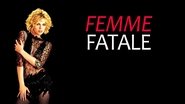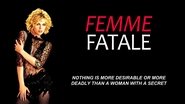grahamcarter-1
Scopophilia is Greek for 'love of looking;' Brian DePalma, like Dario Argento and Hitchcock is always looking. And so are his characters. In the opening of 'Femme Fatale' (2002), Laure is watching Billy Wilder's 'Double Indemnity' (1944). She and her 'gang' are about to steal a fortune in diamonds at the Cannes Film Festival, from the girlfriend of film director Regis Wargnier (playing himself, his film played Cannes that year). The plan is for Laure to successfully seduce her in the bathroom stall while Wargnier's 'East-West' plays on the big screen. Now, it strikes me that as 'meticulous' as the plan sounds, it is really fraught with potential failure! Will Laure's seduction happen on cue? Will security take a leak on cue? (The last five minutes of the film make you realise the seduction was a dead certainty… ). What saves it is the bravura filmmaking. The heist shows a technical wizardry that reminded me of the best bits of DePalma's 'Mission: Impossible' (1996).He has made remarkable use of the split-screen technique before, but never has it been so self-reflexively and personally deployed as it is here. To slowly introduce the technique, during the heist he uses 'natural' screen dividers, such as toilet stall walls, to divide the screen. This results in later, when he actually does split the screen that the divide doesn't seem so gimmicky or jarring. Twenty minutes in and the blonde Laure has performed a double cross. We then cut to a rainy day as Nicolas watches from up high on his balcony; he is a photographer (Laure was impersonating a photographer at the heist), and he snaps Laure who has donned a dark wig, and will in more than one way become Lily. About half an hour into the film DePalma begins to caress, or is it 'lull' us with running water, ticking clocks, Pino Donnagio music (but by Ryuichi Sakamoto), and then a sudden crack of thunder sends us the message that 'something else' is going on here as Laure is in the bath at Lily's parents' house and in walks 'Lily,' upset and crying on the day of her funeral, the overflowing fish tank is a big clue… As Roger Ebert correctly assesses; "This is a movie about watching and being watched, about seeing and not knowing what you see."Seven years after the heist, (so therefore, based on when the film was released, we are now in the future!), Laure unwillingly returns to Paris; she is 'Lily' and married to the American ambassador. The "Déjà Vu 2008" poster that decorates a telephone booth outside Nicolas' apartment may seem like a simple wink to the audience, but the use of the painting "Ophelia" (1852), by John Everett Millais, in the poster points to Laure's trouble with water. In Argento's own 'Trauma' (1993), and Argento fan Chang Youn-hyun's film 'Tell Me Something' (1999), the Millais painting is used as similar visual shorthand. And mentioning Argento, DePalma again uses the surprise reveal from Argento's 'Tenebre.'A classic 'femme fatale,' Laure packs a gun and uses her awareness of men to devour them and spit them out. She turns very nasty in the scene on the bridge, and Nicolas becomes acutely aware of her intentions. The film becomes very dark indeed, with them going to a bar not dissimilar to 'One Eyed Jacks' in David Lynch's 'Fire Walk With Me' (1992), where all the patrons are men wearing black; apparently not a gay bar, but more a nest of thieves. In the climax on the bridge, Laure is thrown in the river, having finally been tracked down by her double crossed cohorts; but look, once she is in the water she is nude, born again, she has a second chance.Arguably the most personal film DePalma has made since 'Body Double', 'Femme Fatale' is nowhere near as dark a film (the Argento within is harder to find, but it is there with an outsider investigating, seeing and not seeing). It comes complete with a typically frustrating DePalma denouement… I suppose he is allowed to use dream sequences, Aeschylus' invented them in 'The Persians' in 472 BC.
SnoopyStyle
Mystery woman Laure Ash (Rebecca Romijn) and her accomplices steal a valuable jewel during the Cannes film festival. The heist goes wrong and she escapes with the jewel. In Paris, she's mistaken for her doppelganger Lily by a couple. Laure gets thrown off a balcony by her accomplice Racine. She wakes up after the couple brings her to Lily's apartment. Lily had disappeared after her husband and daughter's deaths. Lily returns home and commits suicide. Laure takes over Lily's identity. She flies to American. On the plane, she catches the eye of Bruce Watts (Peter Coyote). Seven years later, she returns to Paris as the wife of Ambassador Watts. Nicolas Bardo (Antonio Banderas) is a paparazzi who gets entangled with her. Her old accomplices Racine and Black Tie are still after her.This has many of the hallmarks of a Brian De Palma film. His style is everywhere. The movie starts with a overly complicated robbery. Then it goes off with so many complicated coincidences that it becomes unbelievable. It becomes an exercise more than a story. There are also a couple of questions about logic. It may be more advantageous to keep the first act a secret from the audience and reveal each secret for shock value. The movie is too complicated for its own good.
Spikeopath
**SPOILER ALERT - The last paragraph makes reference to a 1940s film that constitutes a spoiler. ** There rarely seems to be anything in between where Brian De Palma films are concerned, cinematic lovers of all kinds by and large either trash or laud his films. Femme Fatale is no different, one critic - both professional or amateur - will have it as a 1/10 movie, another will have it at the maximum rate available. Femme Fatale is high grade stuff if one is either a De Palma fan or a lover of film noir. Conversely if these two things don't tick your film loving boxes then the law of averages suggests you should have - or should - stayed/stay away from it.De Palma opens up the doors to his fun house and invites noir lovers to come on in and enjoy. It's difficult to write about the plot because it holds many twists and turns, it's a veritable supply of uppers and downers, twisters and benders, all sexed up and pumped full of De Palma's trademark tricks and devilish rug pulls. In truth the story and set-up is predictable, but the journey is what makes the pic ooze quality and bare faced cheek, with the director giggling away like a schoolgirl in the background.Opening up with a sequence that sees our titular fatale (Rebecca Romijn-Stamos) watching famed noir classic Double Indemnity, De Palma proceeds to homage and love the film noir world. As he uses split-screens, canted angles, up-tilt shots, shadow plays etc, the narrative pulses with eroticism and impending cruelty, this really is a femme fatale based movie of the grandest kind. As events unfurl, with hapless photographer Nicola Bardo (a fun packed Antonio Banderas) caught in the web, Ryuichi Sakamoto's magnificent classical based score swirls around like some sort of peeping tom. The latter of which finds a shifty accomplice in Thierry Arbogast's noir photography.It's a picture awash with dupes, dopes and vengeful criminals, where the themes of identity, duality, sexuality and distorted perceptions gnaw away at those investing fully in the viewing experience. Some critics (prof and amat) have lazily likened the film to David Lynch's Mulholland Drive, as if De Palma in 6 short months watched Lynch's movie and then knocked this film out! The copy-cat charge as funny as the rug-pull that De Palma pulls here. Besides, as any film noir lover will tell you, this has more in keeping with Fritz Lang's 1944 noirer "The Woman in the Window" than Lynch's film, which is no bad thing at all, and De Palma knew that. 8/10
srswofford
I'm not a huge movie buff, so I just saw this movie on cable ten years after it was made. Aside from Body Double (one of the best movies ever made), and perhaps Bonfire of the Vanities and Blow Out, this is De Palma's best work. The star, Rebecca Romijn, is fantastic in a dual role, and viewers will hate her until the very end. Perhaps that is why the box office was not very good?? No one will be able to predict the end of this movie, it is so unexpected. There are scenes in this movie that you will have to work hard to fit in. I need to watch it again for that reason, but it also a reason that the movie is so good. If you get the entire movie the first time, it's not that great a movie. How the producers spent $35mil on this movie, however, is beyond me. Eastwood could have done it for less than a third of that.







